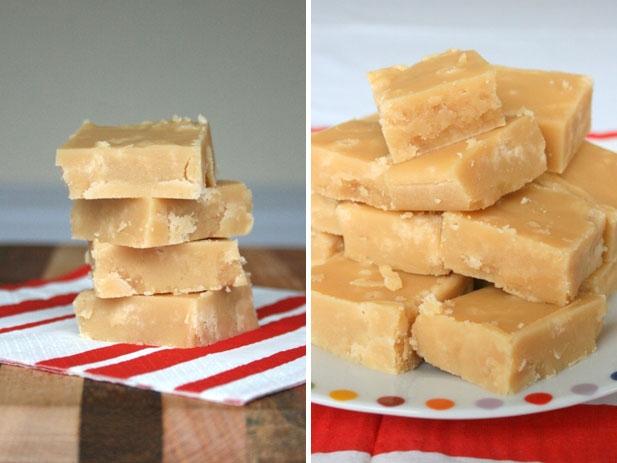The science behind fudge
 I’m always a bit reluctant to make sweets. Baking cakes and cookies, that’s not too scary but using a sugar thermometer and working with sugar syrup can be pretty intimidating. If you relate to this, I think you may enjoy reading about the science behind fudge. Download printable version of this recipe.
I’m always a bit reluctant to make sweets. Baking cakes and cookies, that’s not too scary but using a sugar thermometer and working with sugar syrup can be pretty intimidating. If you relate to this, I think you may enjoy reading about the science behind fudge. Download printable version of this recipe.
First, a little about making sweets (or candy, as Americans call it). All candy is basically made from sugar syrup, whether it’s fudge, nougat, toffee or peanut brittle. The main difference is the texture, which is determined by two things: the size of the sugar crystals in the candy, and the concentration of the sugar. Toffee is smooth with no sugar crystals, whereas fudge has tiny crystals that give it that texture. Toffee also has a much higher sugar concentration than marshmallows, nougat or fudge, making it more solid and heavy.
 The concentration of sugar is determined by the temperature of the sugar syrup that makes the candy (which is why a candy thermometer is needed), and each type of candy falls in a different temperature range. With fudge, the temperature for the syrup ranges from about 112-116°C. We’ll aim to get ours to 115°C. Now that you know all of that, we can make some fudge.
The concentration of sugar is determined by the temperature of the sugar syrup that makes the candy (which is why a candy thermometer is needed), and each type of candy falls in a different temperature range. With fudge, the temperature for the syrup ranges from about 112-116°C. We’ll aim to get ours to 115°C. Now that you know all of that, we can make some fudge.
Fudge is made up mostly of sugar and cream (condensed milk or evaporated milk are sometimes used instead). Most recipes use double the amount of sugar to cream.
 We’ll use the following:
We’ll use the following:
3 cups sugar
1 1/2 cups cream
1/4 cup golden syrup (this helps prevent crystallization of the syrup)
2 tbsp butter (to make the fudge extra rich and creamy)
We’ll also need:
A heavy saucepan (if your pan is too thin the syrup might burn)
A candy thermometer
A 20cm square baking pan
A large mixing bowl
Keep in mind that during the boiling process we want to prevent crystals from forming in the mixture so that our fudge doesn’t turn out ‘sandy’. There are a few things you can do to prevent this:
- Warm your thermometer before inserting it into the mixture.
- Use hot water and a pastry brush to wash down crystals that form on the side of the pan.
- Use a wooden spoon for stirring, instead of a metal one.
Now for the method:
1. Calibrate your thermometer. This can be done by putting it in a pot of boiling water and taking a reading. The amount it differs from 100°C is the amount it needs to be calibrated by.
TIP: Hold the thermometer so it doesn’t touch the bottom of the pot or pan as this can disturb the reading.
2. Butter the baking pan before you start.
3. Set aside the 2 tbsp of butter in the mixing bowl.
4. Cook the sugar, cream and syrup in the saucepan over low-medium heat, until the sugar has dissolved. This should take about ten minutes, and you can stir it constantly to help the dissolving process.
 5. Now raise the heat to medium and bring the mixture to the boil.
5. Now raise the heat to medium and bring the mixture to the boil.
6. Attach the thermometer to the pan, and continue to boil without stirring, until the mixture reaches 115°C (take into account the calibration from Step 1 here).
 7. Transfer the mixture to the mixing bowl with the butter, not scraping the bottom of the pan, and let the mixture cool until it reaches about 60°C.
7. Transfer the mixture to the mixing bowl with the butter, not scraping the bottom of the pan, and let the mixture cool until it reaches about 60°C.
8. Now stir the mixture until the fudge thickens and lightens in colour. You want it to change texture, but don’t let it get too thick to pour out again.
9. After about 5 minutes of stirring, pour it into the prepared pan.
10. Leave it to cool at room temperature for about an hour, after which you can put it in the fridge to set.
11. When it is set, you can cut it into pieces.
Fudge makes a great gift, especially when packaged beautifully. So if you can’t eat it all yourself, you can always share it with your friends. Enjoy!

